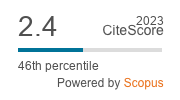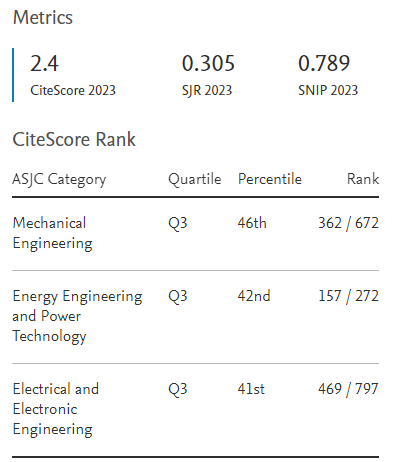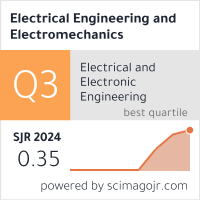A METHOD OF DETERMINING THE ABILITY OF THE ARRESTER TO ABSORB ENERGY WITHOUT BREAKING THE HEAT BALANCE
DOI:
https://doi.org/10.20998/2074-272X.2015.4.13Keywords:
varistor, surge arrester, method, mathematical model, voltage, current-voltage characteristics, heat balanceAbstract
Purpose. The aim of this study is to obtain a method for determining the capacity surge arrester nonlinear absorb energy without breaking the heat balance in modes of long-term application of operating voltage, which allows for analysis of their work in terms of violations as electricity. Methodology. For values of the energy passing through the arrester must be able to determine the current value for the voltage value in the area of leakage current-voltage characteristics. We have carried out calculations of the energy passing everywhere arrester for certain periods of time based on the current-voltage characteristics obtained experimentally. Analysis of the experimental current-voltage characteristics of resistors and literature led to the important conclusion that the dielectric properties of the ceramic varistor affect the value of active power losses in the arrester only when the active component of the leakage current is very small. This is confirmed by the characteristics of different classes of varistor voltage. This property of varistors and surge arresters shows the need to consider how the dielectric and conductive properties of the varistor ceramics in the analysis of work in the area of the arrester leakage current-voltage characteristic. These results demonstrate the need to clarify the mathematical model and the method for determining the energy dissipates in the area of the arrester leakage current CVC with their account. Results. The study, an improved mathematical model for calculating energy affects surge arrester during its working life. The study obtained the method, of evaluation capacity surge arrester, maintains heat balance throughout working life. Based on experimentally obtained current-voltage characteristic of the varistors is defined voltage at which surge arrester starts conducting active current. This allowed to receive specified mathematical model for calculating energy affects surge arrester and develop a method of evaluation capacity surge arrester maintain heat balance throughout working life.References
Hinrichsen V. Metal-oxide surge arresters. Basics. JSC «Siemens», 2000. 111 p. (Rus).
IEEE Working Group 3.4.11. Modeling of metal oxide surge arresters. IEEE Transactions on Power Delivery, 1992, vol.7, no.1, pp. 302-309. doi: 10.1109/61.108922.
Darveniza M., Roby D., Tumma L.R. Laboratory and analytical studies of the effects of multipulse lightning current on metal oxide arresters. IEEE Transactions on Power Delivery, 1994, vol.9, no.2, pp. 764-771. doi: 10.1109/61.296255.
Darveniza M., Tumma L.R., Richter B., Roby D. Multipulse lightning currents and metal-oxide arresters. IEEE Transactions on Power Delivery, 1997, vol.12, no.3, pp. 1168-1175. doi: 10.1109/61.636934.
ABB MWK Surge Arrester Datasheet, Medium Voltage Products & Systems. Catalog 2011. Available at: http://new.abb.com/high-voltage/surge-arresters/medium-voltage-arresters (accessed 13 May 2012).
Magro M.C., Giannettoni M., Pinceti P. Validation of ZnO surge arresters model for overvoltage studies. IEEE Transactions on Power Delivery, 2004, vol.19, no.4, pp. 1692-1695. doi: 10.1109/tpwrd.2004.832354.
Pinceti P., Giannettoni. M. A simplified model for zinc oxide surge arresters. IEEE Transactions on Power Delivery, 1999, vol.14, no.2, pp. 393-398. doi: 10.1109/61.754079.
Exlim. Technical information. Guidance on the selection of high-voltage surge arresters produced by ABB. Company ABB UETM, 1996. 24 p. (Rus).
Ozgür U., Hofstetter D., Morkoç H. ZnO Devices and applications: A review of current status and future prospects. Proceedings of the IEEE, 2010, vol.98, no.7, pp. 1255-1268. doi: 10.1109/jproc.2010.2044550.
Khomchenko V.S., Kryshtab T.G., Savin A.K., Zavyalova L.V., Roshchina N.N., Rodionov V.E., Lytvyn O.S., Kushnirenko V.I., Khachatryan V.B., Andraca-Adame J.A. Fabrication and Properties of ZnO:Cu and ZnO:Ag Thin Films. Superlattices and Microstructures, 2007, vol.42, no.1-6, pp. 94-98. doi: 10.1016/j.spmi.2007.04.016.
Goedde G.L., Kojovic L.A., Woodworth J.J. Surge arrester characteristics that provide reliable overvoltage protection in distribution and low-voltage systems. 2000 Power Engineering Society Summer Meeting (Cat. no.00CH37134), 2000. doi: 10.1109/pess.2000.867361.
Kim I., Funabashi T., Sasaki H., Hagiwara T., Kobayashi M. Study of ZnO surge arrester model for steep front wave. IEEE Transactions on Power Delivery, 1996, vol.11, no.2, pp. 834-841. doi: 10.1109/61.489341.
Fernández F., Diaz R. Metal oxide surge arrester model for fast transient simulations. The Int. Conf. on Power System Transients IPST’01, 20-24 June 2001, Rio De Janeiro, Brazil. Paper №01IPST056. Available at: http://www.ipstconf.org/papers/Proc_IPST2001/01IPST056.pdf (accessed 18 September 2013).
Nakada K., Yokoyama S., Yokota T., Asakawa A., Kawabata T. Analytical study on prevention for distribution arrester outages caused by winter lightning. IEEE Transactions on Power Delivery, 1998, vol.13, no.4, pp. 1399-1404. doi: 10.1109/61.714514.
Berger K., Anderson R.B., Kroninger H. Parameters of lightning flashes. Electra, 1975, vol.41, pp. 23-37.
Gryb O.G. Shevchenko S.Yu., Gapon D.A., Ierusalimova T.S., Zhdanov R.V. Bot protection surge in power in the presence of higher harmonics. Visnyk NTU «KhPІ» – Bulletin of NTU «KhPІ», 2014, no.41(1084), pp. 78-86. (Rus).
Selecting, testing and application of metal oxide surge arresters in medium voltage networks. Selection Rules. ABB High Voltage Technologies Ltd. Switzerland, Vetingen, May 1994. (Rus).
Metal oxide surge arresters. Selection of surge arresters and their application in the distribution networks of medium voltage: Info Tyco Electronics. Kyiv, 2011. 18 p. (Rus).
Downloads
Published
How to Cite
Issue
Section
License
Copyright (c) 2015 S. Yu. Shevchenko

This work is licensed under a Creative Commons Attribution-NonCommercial 4.0 International License.
Authors who publish with this journal agree to the following terms:
1. Authors retain copyright and grant the journal right of first publication with the work simultaneously licensed under a Creative Commons Attribution License that allows others to share the work with an acknowledgement of the work's authorship and initial publication in this journal.
2. Authors are able to enter into separate, additional contractual arrangements for the non-exclusive distribution of the journal's published version of the work (e.g., post it to an institutional repository or publish it in a book), with an acknowledgement of its initial publication in this journal.
3. Authors are permitted and encouraged to post their work online (e.g., in institutional repositories or on their website) prior to and during the submission process, as it can lead to productive exchanges, as well as earlier and greater citation of published work.





